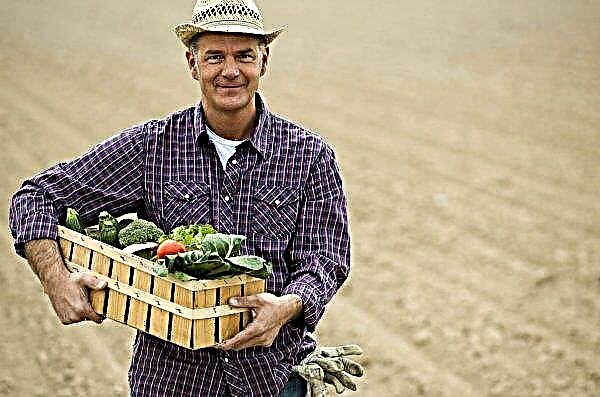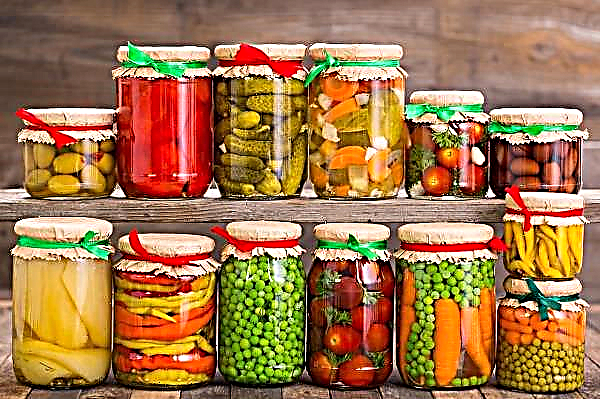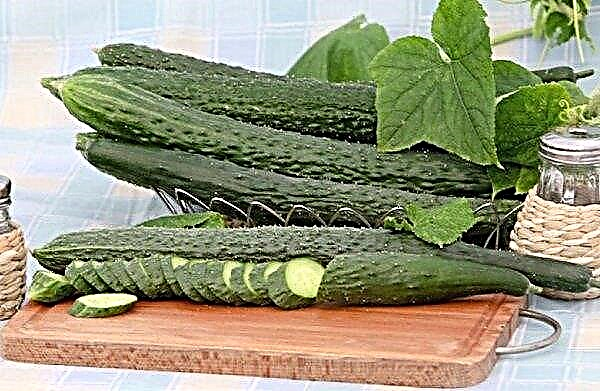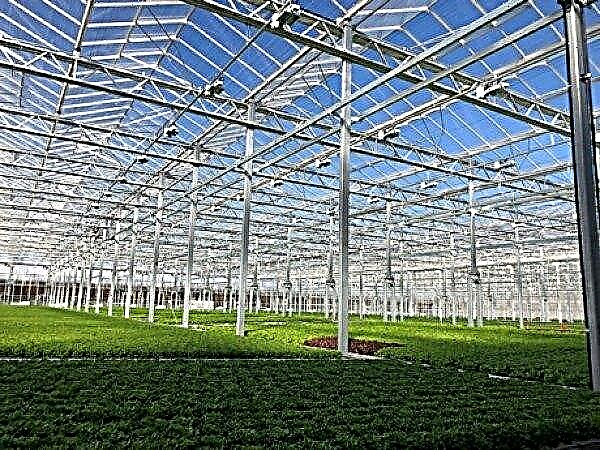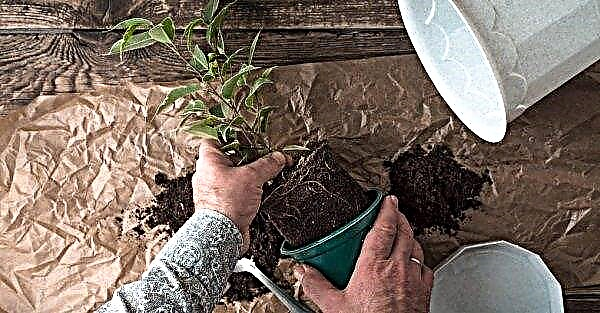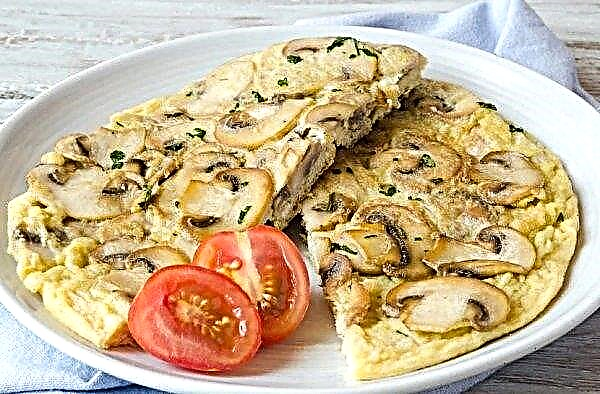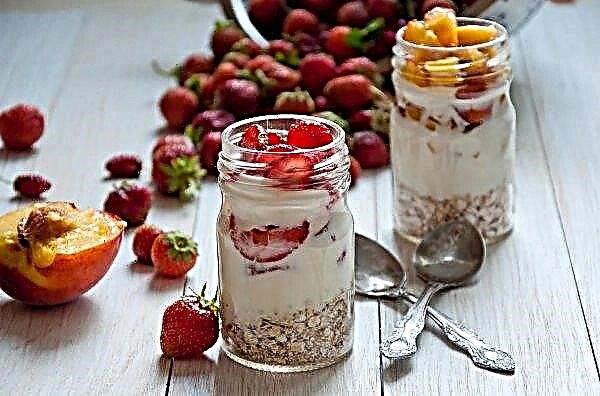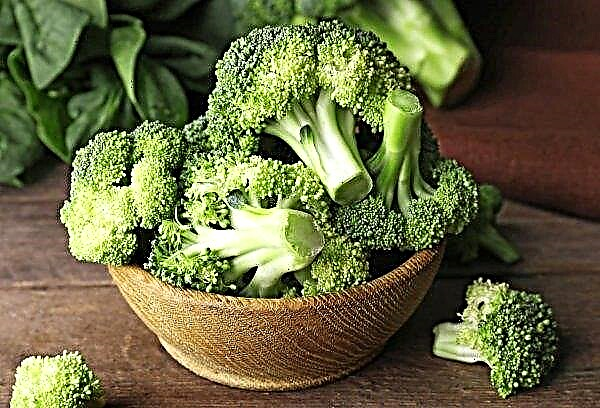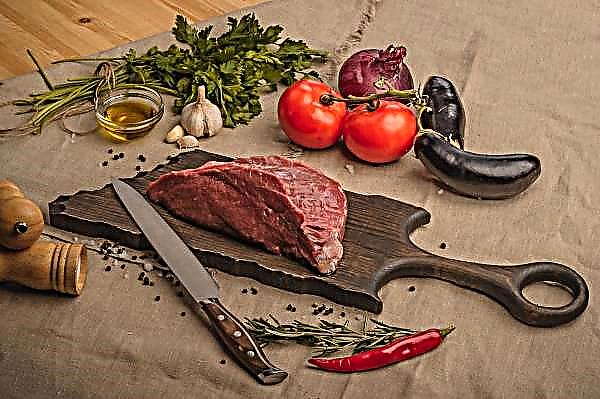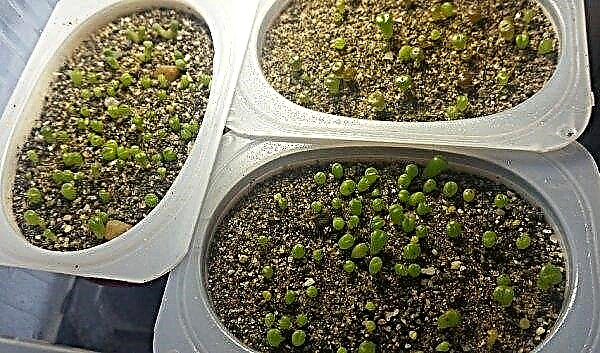Variety Parade is one of the brightest representatives of onion-batun. It is a perennial that comes from East Asia and the temperate regions of Siberia; It is cultivated throughout Eurasia and North America. He has many names: Tatar, angelica, Japanese bow. It tastes like a regular onion in taste and smell, but has no bulbs and is grown on herbs. Read about other features of the variety and the technique of growing it in the review.
Description and characteristics of onions
Batun is a perennial onion that is grown to produce greenery, as well as a decorative garden plant. Unlike other onion varieties, it does not form an onion: there is only a slight thickening of the stem, in which children are formed. After a couple of years, thickets of thick green stems appear on the landing site.
 Flowering of a batun occurs in June.It self-pollinates and forms both male and female flowers.. Pedicels are very beautiful and thanks to them the plant can serve as a decorative one.
Flowering of a batun occurs in June.It self-pollinates and forms both male and female flowers.. Pedicels are very beautiful and thanks to them the plant can serve as a decorative one.
Parade variety characteristics:
- originator: Dutch company BEJO ZADEN B. V .;
- basic information: evergreen, grassy perennial; which takes up little space, can be grown in the garden or in the flower garden;
- ripening period: medium early, 60 days;
- leaves: cylindrical basal, erect, 40-60 cm long;
- color: blue-green;
- flavor: garlic;
- productivity: very high, up to 4.2 kg / m²;
- resistance: resistant to shooting and bulb diseases;
- application: goes well with various vegetables, egg dishes, salads and dressings, fried poultry, stews, casseroles and baked fish; used to flavor food.
 A batun is a bow on a feather.
A batun is a bow on a feather.Among the advantages of the variety are noted that it is characterized by a stable yield and excellent appearance of the leaves. They do not turn yellow and grow quite quickly. In addition, this onion has a high content of vitamin C. As for the crop, for the entire growth period, from spring to autumn, the greens are cut several times.
There are no significant shortcomings in the batun; just keep in mind that if you need bulbs, you need to choose another grade.
Important! After the thermometer shows +27°C, the onion-baton will hibernate. He does not tolerate such weather. To make it continue to grow, water the crops with cold water.
Optimal growing conditions
Onion Parade thrives in well-drained soil rich in organic matter. A feature of the variety is that it grows on almost any type of soil.
Onions also need a full sunny daylight, but even if the plot periodically turns into shade, this does not affect the yield. The parade is tolerant of drought, but still try to carry out regular watering.
 The desired level of acidity is 6-7 pH
The desired level of acidity is 6-7 pH
Sowing and cultivation of varieties in the open ground
There are three ways to grow onion-batun:
- dividing the bush;
- sowing seeds into the ground;
- sowing in soil through seedlings.
Perennial onions develop peduncles, provided that it is periodically exposed to low temperatures. From them will be obtained seeds that can be planted in the next plot. The exceptions are the tropics and the equatorial belt - there, due to the lack of subzero temperatures, the onion does not go into the next vegetative cycle and does not form peduncles, therefore it propagates only by division. To divide, the age of the bush must be at least 3 years. Sowing with seeds is possible annually. Sowing time is spring. Seeds can be sown several times per season with an interval of several days.
To divide, the age of the bush must be at least 3 years. Sowing with seeds is possible annually. Sowing time is spring. Seeds can be sown several times per season with an interval of several days.
The main dates for growing the crop:
- landing: April - July;
- flowering: May - August;
- picking greens: July - August.
Seeding Technology:
- Provided that the soil warms up to + 10 ° C, the site is dug up.
- Prepare furrows 1 cm deep and moisturize them.
- Seeds are added to the furrows (to be convenient, they can be mixed with sand).
- Gently cover the seeds with a small layer of soil.

The distance between the furrows is 10-15 cm. In appearance, the seedlings will be very similar to ordinary grass, so they need to be planted so as not to be confused with weeds. To prevent seedlings from drying out, regularly moisten the soil.
Did you know? People have been eating onions for more than 7,000 years. Archaeologists discover the remains of onions in the Bronze Age settlements.
Onion Care Rules
Onion-batun is very unpretentious and does not need special conditions for growing. But small efforts to get the crop will still be needed.
Onion care will consist of:
- regular watering, especially in hot and dry weather;
- loosening row spacings and removing weeds;
- fertilizer application on depleted soils - once a year in early spring;
- periodic collection of green pen.
Site selection and soil preparation
Onions Parade refers to frost-resistant plants, so it is sown since March. You can start even a month before the last spring freeze. The cold will not harm the seeds - they will simply begin to germinate immediately when the conditions are favorable. Onions love soil rich in nutrients, so when preparing the site, you can make organic fertilizers by mixing them with soil. It can be: turf land, rotted manure, compost.
Onions love soil rich in nutrients, so when preparing the site, you can make organic fertilizers by mixing them with soil. It can be: turf land, rotted manure, compost.
Basic requirements for the site:
- Lighting: the presence of bright sun or partial shade;
- site orientation: can be oriented to the south, west, east or north;
- possible planting in open ground or in a greenhouse;
- any soil: loam, chalk, sand, clay;
- soil moisture: constant moisture without periods of drought;
- soil acidity: any (optimally - 6-7 pH).
The process of planting seed in the ground
A bush that has reached the age of 3 years, grows quite well and consists of several children. After digging it, cut the roots and divide into parts so that each had 3-4 children. Take them to new places. The best time for this procedure is the end of summer or the beginning of autumn.
Watering and fertilizing
Onion roots are small in size, so be sure to ensure that the soil does not dry out. Water it once a week, as it dries, to a depth of 3-5 cm.
Any plant needs nitrogen, phosphorus, and potassium to grow. Nitrogen is responsible for the growth of plant tissues (vegetation), phosphorus - for the development of the root system, potassium - for cell metabolism. Do not water in the evening. Long-term dampness contributes to the growth of pathogenic bacteria. The first feeding is carried out in the phase of 3-5 leaves. The goal is to create the conditions for the formation of a good root system. To do this, urea and potassium chloride are added (1 tbsp.spoon diluted in 10 liters of water).
Do not water in the evening. Long-term dampness contributes to the growth of pathogenic bacteria. The first feeding is carried out in the phase of 3-5 leaves. The goal is to create the conditions for the formation of a good root system. To do this, urea and potassium chloride are added (1 tbsp.spoon diluted in 10 liters of water).
The second time they feed, to enhance the development of the pen; by this time the onion should produce about 8 leaves. The composition of the mixture may be the same as with the first feeding. Since onions do not belong to intensive consumers of nutrients, there is no need for regular feeding. It is enough to immediately provide good conditions for development.
Did you know? In China, diluted onion juice is used to spray plants from aphids and white ants.
Soil cultivation and weeding
Weeds compete with onions for nutrients, so they must be removed. Do this with simultaneous loosening of row-spacing 1-2 days after each watering. It also improves oxygen supply to the roots.

To prevent the growth of weeds, mulching aisles is used. To do this, use organic materials (straw, sawdust) or inorganic (agrofiber). Mulch also prevents soil compaction and rapid drying of moisture.
Plant pests and diseases
Batun practically does not get sick. Sometimes it can be attacked by an onion fly, but only if an ordinary onion is planted nearby, which was the original purpose of the insect.
Insects that can hit the bat:
- Onion fly can attack any onion, including leek, garlic and decorative varieties. It lays eggs, from which the larvae hatch and settle between the stems and roots. In those species that have an onion, the larvae will advance towards it. As a result, the plant dies after a few days.

- Onion tick affects the roots - they are covered with brownish dust, crumble. New roots do not grow and the plant dies.
 Onion mite defeat
Onion mite defeat
In all cases, it is difficult to detect pests, since the roots are not visible to the farmer, and when the plant begins to wither, it remains only to destroy it. It is also advisable to cultivate the soil at the planting site with boiling water in order to destroy the pests that are in it. An effective preventive measure is to cover the soil with a layer of ash.Wet and often warm weather favors the multiplication of various bacteria.
Among the most common are:
- Gray mold - the result of the action of Botrytis. It spreads very quickly, especially if the weather is favorable. Spots appear on the leaves, which soon cause the death of the plant. The onion's sensitivity to rotting is manifested if it has been in high humidity for a long time. The infected plants are dug up and burned.

- Downy mildew manifested in high humidity, if the planting is too thick. The leaves are covered with a gray coating, similar to flour, and then darken and die.

- Alternariosis manifests itself in the form of white spots with a watery outline. As it develops, such a stain becomes like brown annual rings on a tree trunk. Most often, the fungus attacks old or dying leaves.

Farmers offer to comply with crop rotation rules and provide optimal conditions for cultivation: soil, sun, moisture and microclimate. Strong and healthy plants are not affected by pests and diseases.
Important! The peculiarity of onions on the feather is that to eat it after processing chemicals can be no earlier than 3 weeks.
Basic preventive measures:
- grow onions from seeds, they are not affected by diseases;
- always burn infected plants away from the site;
- treat the soil with boiling water - this helps both from ground pests, and from some fungi;
- does not use compost as a fertilizer - it attracts insects;
- watch your shoes - do not walk on previously affected areas, and then on new ones.
So, growing onion-batun on greens is not difficult. For an average family, 3 bushes are enough to provide themselves with a reliable source of fresh vegetables. And with proper organization, planting onions Parade can guarantee a steady income.


 Onion mite defeat
Onion mite defeat


